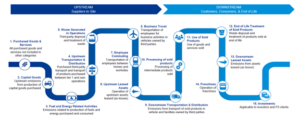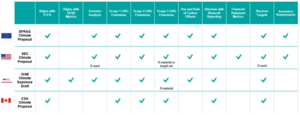Trends in GHG Reporting & Requirements
December 12, 2022An estimated 10.5% of Canada’s greenhouse gas emissions are attributable to the retail sector1. The pressure on retail organizations to report and manage their greenhouse gas (GHG) emissions is rising as regulators introduce increasingly robust requirements.
Changes in the reporting of Scope 1, 2 and 3 emissions
As retailers mature their processes for calculating, reporting and managing Scope 1 & 2 emissions, focus is now turning to Scope 3 emissions (i.e. those emissions outside a company’s direct control) and its associated challenges, including supply chain visibility, data collection and ability to mitigate these emissions. This shift toward understanding and quantifying upstream and downstream emissions is a critical next step in meeting our global carbon reduction goals, as Scope 3 emissions can account for 80 percent of the total carbon footprint for many companies and as much as 98 percent for home and fashion retailers.
The first step towards managing Scope 3 emissions is for an organization to identify which ‘categories’ apply to it in a significant way. Reporting standards such as the Corporate Value Chain (Scope 3) Accounting and Reporting Standard issued by the GHG Protocol provide specific guidance around how to define and differentiate between the Scope 3 categories and how to determine which apply.

Even if your organization is not yet ready to report on Scope 3 emissions, your suppliers may begin asking for this information for their own purposes. As the value chain becomes more interested in understanding, managing and ultimately reducing Scope 3 emissions, organizations can expect to begin fielding these types of requests from a variety of new places, including through new requirements.
What metrics are included in reporting?
Reporting on Scope 1, 2 & 3 emissions are the most common climate-related metrics, but additional metrics are also becoming more widely requested and reported:
Climate risk metrics
Disclosure of asset exposure to climate-related risks as well as those aligned with climate-related opportunities to better understand potential financial exposure and potential changes in revenue and profitability, including carbon pricing.
Capital deployment metrics
Disclosure of the amount of capital expenditure, financing or investment deployed toward climate-related risks and opportunities, giving an indication into the extent to which enterprise value might be affected.
Climate-related financial impacts
Disclosure of historical financial impact or forward-looking financial estimates of climate-related events (e.g. cost of extreme weather events) or climate-related products (e.g. green revenues).
Internal carbon pricing
Disclosure of an internal or shadow price on a ton of carbon used by an organization to analyze and assess business decisions such as capital investments or to support behaviour change (e.g. applied to business travel).
Remuneration
Disclosure of the proportion of executive management remuneration which is linked to climate considerations as these policies are important incentives and therefore provide insight on governance, oversight and accountability.
What are the latest proposed climate reporting requirements?
There are various proposals coming out from global regulatory bodies that will govern publicly traded companies. Even if an organization is not public, it is important to pay attention as capital providers, investors and customers impacted by these rules may begin to expect the same information in the near future.

What are the benefits of calculating and reporting your emissions?
Although regulation requirements for climate-related reporting may often be the initial driver behind uptake, companies are recognizing additional benefits, including:
- Meeting customer and investor pressures – customers are driving ESG adoption while growing more sophisticated and investor pressures are quickly mounting.
- Reduced operating costs because of information that allows for improved efficiencies such as decreased energy consumption. Organizations that continue to rely on high-emitting energy sources will see their costs in this space go up.
- Increased transparency resulting in reduced reputational and regulatory risk.
- Increased decarbonization opportunities, allowing hotspots to be identified and initiatives to be targeted.
Where does my organization go from here?
- Determine which requirements apply to your organization and what activities will be in scope, then educate your organization as necessary.
- Develop a robust GHG inventory by taking stock of the differences between relevant protocols and current practices. Analyze documentation, processes, systems, controls and data quality to ensure a robust baseline.
- Assess your readiness by considering your current reporting practices and how those align with relevant frameworks and requirements.
- Use data, technology and analytics to foster better outcomes. Data can provide insights into market opportunities, leading practices and target operating models. It can enable climate ambitions and enhance decarbonization levers.
KPMG can help organizations enhance, accelerate, and build a sustainable future that drives growth and profitability. Learn about how we can support your organization’s ESG and sustainability strategies and goals today.
Authored by Roopa Dave
Partner, Sustainability Services
KPMG in Canada



